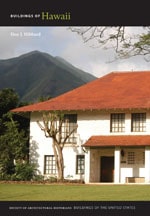You are here
East Hawaii Cultural Center (Hilo District Courthouse and Police Station)

This two-story, reinforced-concrete building nicely complements its neighbor, the Mutual Telephone Company building (HA37), and contributes to the pleasant ambiance surrounding Kalakaua Park. Rendered in a modernistic Hawaiian style, with its double-pitched hipped roof and first- and second-story lanai, it presents a hospitality seemingly more suited for an art center than a hall of justice. In 1969, the district court moved from this building to the new state office building in Kaikoo, and then in 1975, the police department left the building for larger quarters. Since 1980 the East Hawaii Cultural Center has leased it from the County of Hawaii, and has been responsible for its rehabilitation.
Frank Arakawa was born and raised in Hilo, and served as Deputy County Engineer at the time he designed this building. He was one of the first nisei (second-generation Japanese in Hawaii) to graduate from Stanford with a degree in civil engineering, and one of the earliest Japanese to practice architecture in Hawaii. His other works include Hilo's Pacific Building (1922; Keawe Street), St. Joseph's Parish Hall (1927; Haili Street), Hilo Junior High School (1928; 450 Waianuenue Avenue), and Honokaa Elementary and High School (HA55).
Writing Credits
If SAH Archipedia has been useful to you, please consider supporting it.
SAH Archipedia tells the story of the United States through its buildings, landscapes, and cities. This freely available resource empowers the public with authoritative knowledge that deepens their understanding and appreciation of the built environment. But the Society of Architectural Historians, which created SAH Archipedia with University of Virginia Press, needs your support to maintain the high-caliber research, writing, photography, cartography, editing, design, and programming that make SAH Archipedia a trusted online resource available to all who value the history of place, heritage tourism, and learning.














